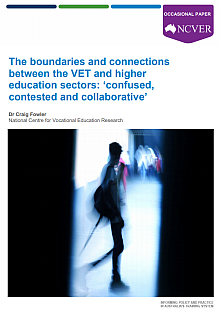
The UNESCO-UNEVOC International Centre: Who We Are | What We Do | Working With Us | Get in Touch
The UNEVOC Network: Learn About the Network | UNEVOC Network Directory
For Members: UNEVOC Centre Dashboard
Thematic Areas: Inclusion and Youth | Digital Transformation | Private Sector Engagement | SDGs and Greening TVET
Our Key Programmes & Projects: BILT: Bridging Innovation and Learning in TVET | Building TVET resilience | TVET Leadership Programme | WYSD: World Youth Skills Day
Past Activities: COVID-19 response | i-hubs project | TVET Global Forums | Virtual Conferences | YEM Knowledge Portal
Our Services & Resources: Publications | TVET Forum | TVET Country Profiles | TVETipedia Glossary | Innovative and Promising Practices | Toolkits for TVET Providers | Entrepreneurial Learning Guide
Events: Major TVET Events | UNEVOC Network News

| Author/s: | Dr. Craig Fowler |
| Publisher/s: | NCVER |
| Published: | 2017 in Australia |
| Licence: | CC BY |
| ISBN online: | 978 1 925173 72 7 |
Internationally, Australia’s tertiary education system, comprising the higher education and vocational education and training (VET) sectors, is highly regarded, with both sectors subject to ongoing national review and reforms. This paper explores in detail the multiple issues that lie at what might be termed the ‘boundaries and connections’ between these sectors.
One marker that delineates the sectoral boundaries is the Australian Qualifications Framework (AQF), in particular AQF level 5 (VET diploma) and AQF level 6 (associate degree/advanced diploma). VET diplomas sit on one side of this boundary, and those financed under the previous VET FEE-HELP program (to be replaced by the new VET Student Loans program) have recently attracted considerable public scrutiny.
The conditions for the operation of the tertiary education system, especially the boundaries and connections between the VET and higher education sectors, are set by national and state/territory policies, embodied in regulations, programs and funding. In exploring the multiple issues that have evolved at the sectoral boundaries and connections, this paper highlights examples that have eroded clear differentiation between the sectors, as well as their mutual value within a coherent tertiary education system. The present situation has been caused by a combination of: differing sector-specific national policies and agreements; differing sectoral financing/funding; and differing sectoral legislation, regulation and standards, as well as overlapping qualification frameworks and different standards for courses and qualifications.